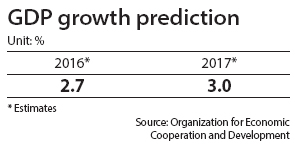OECD cuts its growth forecast for Korea

Growth for next year could be as high as 3 percent, but there are major challenges, such as a decline in exports due to slowing growth in the Chinese economy.
The exports slump and low productivity were main factors for the cut, the organization said in the “OECD Economic Outlook,” which was released on Monday.
“Korea is experiencing a spell of slower growth and low inflation,” the report said. “Productivity is low due to large gaps between manufacturing and services, and large companies and small and medium-sized enterprises. Problems in the labor market raise inequality and poverty, and discourage employment.”
For the export-driven economy, demand from emerging markets and China was weak, according to the report. “A sharper-than expected slowdown in China would be very detrimental to Korea, given that its merchandise exports to China accounted for 10 percent of GDP in 2014,” the OECD said.
The OECD thought highly of Korea’s ongoing structural reform and said that the economy can grow by more than 3 percent and meet the goal of a 70 percent overall employment rate. “On the upside, effective structural reforms could reignite export growth and reverse the decline in export performance,” the OECD said.
The report also predicted a chance for further monetary easing. “The Bank of Korea cut its policy interest rate in June 2015 to a record low 1.5 percent and reduced its inflation target to 2 percent for the period 2016 to 2018,” the OECD said. “There is a case for further monetary easing, as inflation is still far below the new target, and monetary decisions need to take into account risks to financial stability, including those stemming from household debt and capital flows.”
The OECD also warned about rising household debt and large corporate loans to weak sectors, such as shipbuilding. “Korea’s household debt was 163 percent of household disposable income in 2014, well above the OECD average of 137 percent,” the report said. “Corporate debt edged up from 101.5 percent of GDP in 2008 to 105.7 percent in 2014, while the number of firms unable to cover interest expenses with operating profits for three consecutive years rose from 12.8 percent in 2009 to 15.2 percent in 2014.”
The report also suggested that additional fiscal stimulus might be required. “After increasing 8.1 percent in 2015, including the supplementary budget, the government spending in 2016 is set to rise by only 0.4 percent, suggesting fiscal drag,” the OECD pointed out. “In this light, additional fiscal stimulus is called for in 2016.”
Furthermore, the OECD recommended that there needs to be changes in the labor market in order for Korea’s economy to rise.
“Labor market dualism in Korea is exceptionally strong. A third of all employees are non-regular workers, such as fixed-term, part-time and dispatched workers and the share of temporary workers reached 22 percent, more than double the OECD average,” the report said. “Focus venture capital on start-ups by facilitating early-stage IPOs in the Kosdaq and Konex markets and taking further steps to jump-start the M&A market through regulatory reform.”
BY KIM YOUNG-NAM [kim.youngnam@joongang.co.kr]










with the Korea JoongAng Daily
To write comments, please log in to one of the accounts.
Standards Board Policy (0/250자)